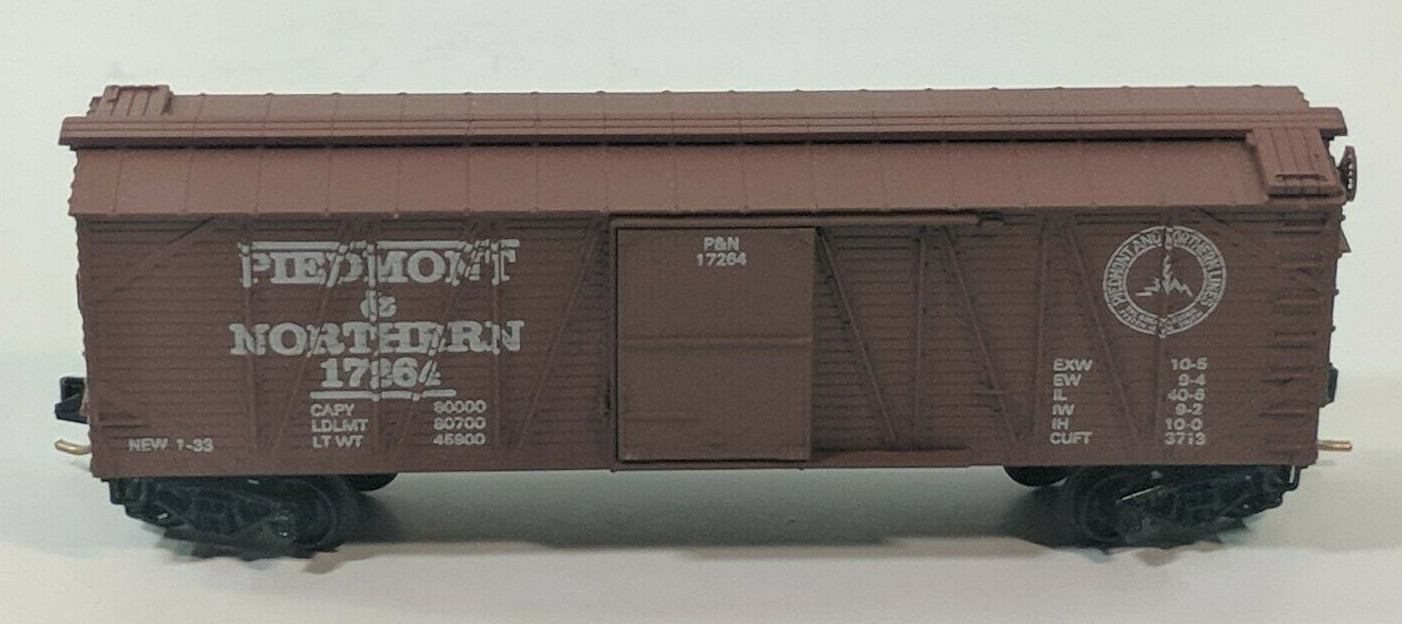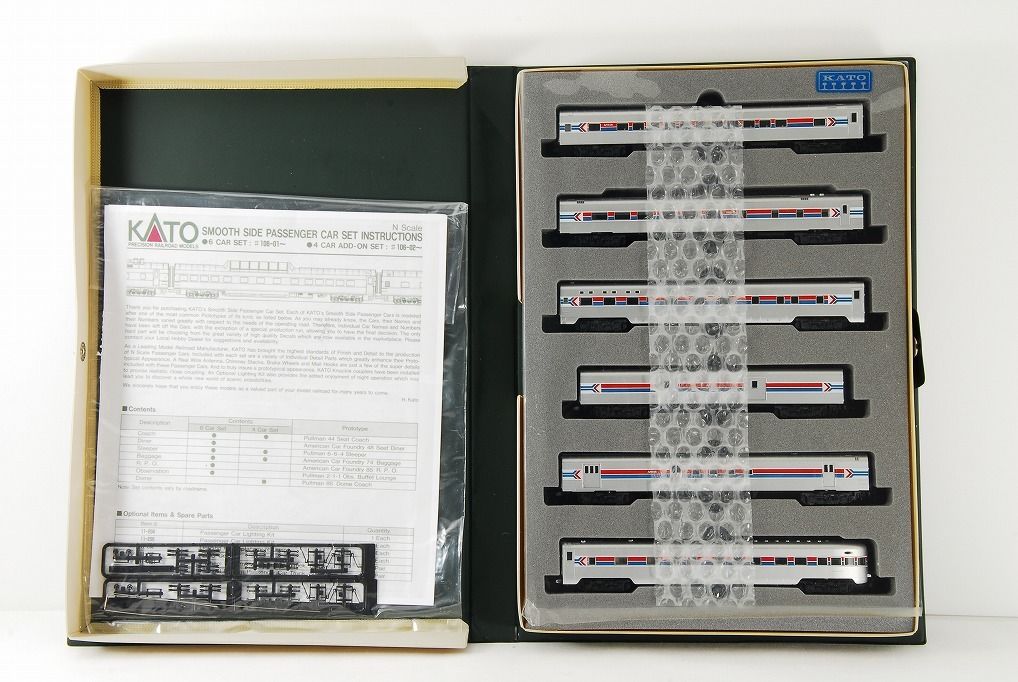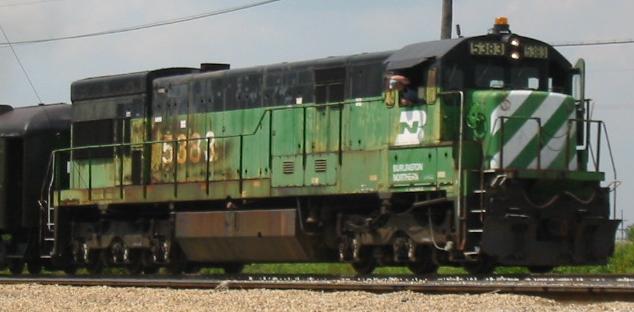Model Information: The GE U23C and U30C models were first released by Kato in 1989. A second release appeared in 1991. Kato reworked this locomotive in 2010 to create a more typical post-2000 model. The 2010 version features a redesigned DCC-Ready mechanism with a new detailed underframe which allows the locomotive to be fitted with body mounted, magnetic knuckle couplers. The two models have only minor detail differences in the shells.
The modern (2010+) version features:
The modern (2010+) version features:
- Locomotives feature directional white LED headlights and illuminated preprinted number boards
- Powerful Kato mechanism powered by a 5-pole flywheel motor and featuring a 9 3/4" minimum turning radius.
- Re-designed body shell to equip the locomotive with body mounted KATO magnetic knuckle couplers.
- DCC friendly and ready for drop in decoder installation.
- Smooth rolling blackened metal wheels.
- Optional untinted clear headlights and number-boards available for using DCC boards with tinted LEDs.
DCC Information:
Models produced since 2010 accept the following plug-in decoders:
- Digitrax DN163K1C : 1 Amp N Scale Mobile Decoder for Kato N scale SD40-2 locos made from year 2006 onward.
- TCS K1D4-NC
Models produced since 2010 accept the following plug-in decoders:
- Digitrax DN163K1C : 1 Amp N Scale Mobile Decoder for Kato N scale SD40-2 locos made from year 2006 onward.
- TCS K1D4-NC
Prototype History: Introduced by GE as a competitor to the EMD SD40 and SD40-2, the U23C and U30C locomotive chassis' were one of GE's earliest locomotive successes. Nicknamed "U-Boats", these units were used in multiple services, pulling coal trains, general freight, and even as a test-power unit for the Department of Transportation's subway car experiments in Colorado.
The 3000 horsepower GE U30C was one of the earliest successes from General Electric in the diesel locomotive market. The U30C has eight tall hood doors per side, a function of the V16 GE FDL diesel motor within. With 600 units sold, the U30C proved to be a viable alternative for customers who were unable to purchase SD40s or SD40-2s from Electro-Motive Diesel (EMD) due to production backlog.
Other than six tall hood doors matching six power assemblies per side, there are very few features which distinguish the U23C from the U30C.
Full GE U30C data sheet on The Diesel Workshop.
Read more on Wikipedia.
The 3000 horsepower GE U30C was one of the earliest successes from General Electric in the diesel locomotive market. The U30C has eight tall hood doors per side, a function of the V16 GE FDL diesel motor within. With 600 units sold, the U30C proved to be a viable alternative for customers who were unable to purchase SD40s or SD40-2s from Electro-Motive Diesel (EMD) due to production backlog.
Other than six tall hood doors matching six power assemblies per side, there are very few features which distinguish the U23C from the U30C.
Full GE U30C data sheet on The Diesel Workshop.
Read more on Wikipedia.
Road Name History: The United States Department of Transportation (USDOT or DOT) is a federal Cabinet department of the U.S. government concerned with transportation.
Its mission is to "Serve the United States by ensuring a fast, safe, efficient, accessible, and convenient transportation system that meets our vital national interests and enhances the quality of life of the American people, today and into the future."
Read more on Wikipedia
Its mission is to "Serve the United States by ensuring a fast, safe, efficient, accessible, and convenient transportation system that meets our vital national interests and enhances the quality of life of the American people, today and into the future."
Read more on Wikipedia
Brand/Importer Information: KATO U.S.A. was established in 1986, with the first U.S. locomotive model (the GP38-2, in N-Scale) released in 1987. Since that time, KATO has come to be known as one of the leading manufacturers of precision railroad products for the modeling community. KATO's parent company, Sekisui Kinzoku Co., Ltd., is headquartered in Tokyo, Japan.
In addition to producing ready-to-run HO and N scale models that are universally hailed for their high level of detail, craftsmanship and operation, KATO also manufactures UNITRACK. UNITRACK is the finest rail & roadbed modular track system available to modelers today. With the track and roadbed integrated into a single piece, UNITRACK features a nickel-silver rail and a realistic-looking roadbed. Patented UNIJOINERS allow sections to be snapped together quickly and securely, time after time if necessary.
The Kato U.S.A. office and warehouse facility is located in Schaumburg, Illinois, approximately 30 miles northwest of Chicago. All research & development of new North American products is performed here, in addition to the sales and distribution of merchandise to a vast network of wholesale representatives and retail dealers. Models requiring service sent in by hobbyists are usually attended to at this location as well. The manufacturing of all KATO products is performed in Japan.
Supporters of KATO should note that there is currently no showroom or operating exhibit of models at the Schaumburg facility. Furthermore, model parts are the only merchandise sold directly to consumers. (Please view the Parts Catalog of this website for more specific information.)
In addition to producing ready-to-run HO and N scale models that are universally hailed for their high level of detail, craftsmanship and operation, KATO also manufactures UNITRACK. UNITRACK is the finest rail & roadbed modular track system available to modelers today. With the track and roadbed integrated into a single piece, UNITRACK features a nickel-silver rail and a realistic-looking roadbed. Patented UNIJOINERS allow sections to be snapped together quickly and securely, time after time if necessary.
The Kato U.S.A. office and warehouse facility is located in Schaumburg, Illinois, approximately 30 miles northwest of Chicago. All research & development of new North American products is performed here, in addition to the sales and distribution of merchandise to a vast network of wholesale representatives and retail dealers. Models requiring service sent in by hobbyists are usually attended to at this location as well. The manufacturing of all KATO products is performed in Japan.
Supporters of KATO should note that there is currently no showroom or operating exhibit of models at the Schaumburg facility. Furthermore, model parts are the only merchandise sold directly to consumers. (Please view the Parts Catalog of this website for more specific information.)
Item created by: Alain LM on 2016-08-21 13:22:30. Last edited by Alain LM on 2018-04-20 01:15:54
If you see errors or missing data in this entry, please feel free to log in and edit it. Anyone with a Gmail account can log in instantly.
If you see errors or missing data in this entry, please feel free to log in and edit it. Anyone with a Gmail account can log in instantly.











